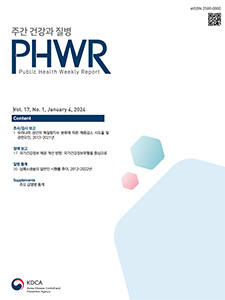Current Issue
Vol.17 No.1, January 04, 2024
-
Surveillance Reports 2024-01-04
 2
2
 306
306
 171
171
Attempts to Lose Weight and Related Factors according to Body Mass Index among Adults in the Republic of Korea, 2013–2021
Doyeon Kim, Yoonjung Kim, Hyejin Kim, Kyungwon Oh
Public Health Weekly Report 2024; 17(1): 1-16 https://doi.org/10.56786/PHWR.2024.17.1.1AbstractWe studied the self-perception of weight status as obese, attempts to lose weight, and related factors according to body mass index in Korean adults using the data from the 2013–2021 National Health and Nutrition Examination Survey. In 2019–2021, 28.3% of normal weight women in their 20s perceived themselves as obese, and 16.2% of underweight tried to lose weight. The rate of perceived weight status as obese has increased since 2013 to 84.6% in men and 94.7% in women with obesity in 2019–2021. However, the rate of attempts to lose weight have decreased to 54.4% in men and 66.1% in women with obesity in 2019–2021. A younger age, a higher level of education, and perceived themselves as being obese, non-aerobic physical activity were associated with attempts to lose weight among both men and women. In women, perceived stress, binge drinking, and excess intake of energy/fat, individuals without chronic disease were associated with attempts to lose weight, whereas in men, current non-smoker was associated with attempts to lose weight.
-
Policy Notes 2024-01-04
 1
1
 217
217
 143
143
Improving Health Information: Focusing on the National Health Information Online Service
Juhyun Jang, Jinhong Kim, Dosang Lim, Sanghui Kweon
Public Health Weekly Report 2024; 17(1): 17-29 https://doi.org/10.56786/PHWR.2024.17.1.2AbstractThe internet is an important tool for increasing opportunities for people who need information about their health. However, it also presents limitations and issues when it comes to utilizing online health information. The Korea Disease Control and Prevention Agency (KDCA) operates the National Health Information Portal to respond to the risks associated with inaccurate or misleading information exposure. The core value of the National Health Information Portal is to provide verified, easily understandable, and integrated information related to health and disease. In pursuit of this core value, the KDCA is establishing a standardized system to facilitate the efficient production and quality management of content. Moreover, It’s making an efforts to generate health information that takes into account consumers’ health literacy. This includes providing training for authors and striving to enhance consumer engagement for utilization. Furthermore, KDCA is connecting channels in a way that enable public to access information, which has been distributed by different institutions, in an integrated and systematic manner from one place. As of 2022, the National Health Information Portal holds and provides 852 types of health information, over 4,000 media items, and 1,070 terms. Achieving results are included in plans outlining the direction of media to long-term policies for disease prevention and health promotion, such as the 5th Health Plan. KDCA is continually seeking ways to further develop the National Health Information Portal, enabling its active utilization as a public platform that integrates and systematically provides health information based on the needs of the public.
-
QuickStats 2024-01-04
 0
0
 137
137
 229
229
Trends in Bystander Cardiopulmonary Resuscitation, 2012–2022
Public Health Weekly Report 2024; 17(1): 30-31 https://doi.org/10.56786/PHWR.2024.17.1.3

pp. 1~2097
Most Keyword
?
What is Most Keyword?
- It is the most frequently used keyword in articles in this journal for the past two years.
Most Read
-
Waterborne and Foodborne Disease Outbreaks in the Republic of Korea, 2023
Myung-Jae Hwang, So Yeon Park, Hyungjun Kim, Se Jeong Yang, Sungchan Yang, Jin Seon Yang
Public Health Weekly Report 2025;18: 17-32 https://doi.org/10.56786/PHWR.2025.18.1.2 -
Implementation Plan for the Coronavirus Disease 2019 Vaccination for the 2024–2025 Season: Recommendations of the 6th Expert Committee on Immunization Practices
Hyewook Hwang, Wookeon Lee, Seohyeon Ahn, Young-Sook Choi, Seunghyun Lewis Kwon, Dongwoo Lee, Eun Hwa Choi, SokGoo Lee
Public Health Weekly Report 2025;18: 90-102 https://doi.org/10.56786/PHWR.2025.18.2.3
Editorial Office
+82-43-719-7569





 Full Text
Full Text Cite
Cite


